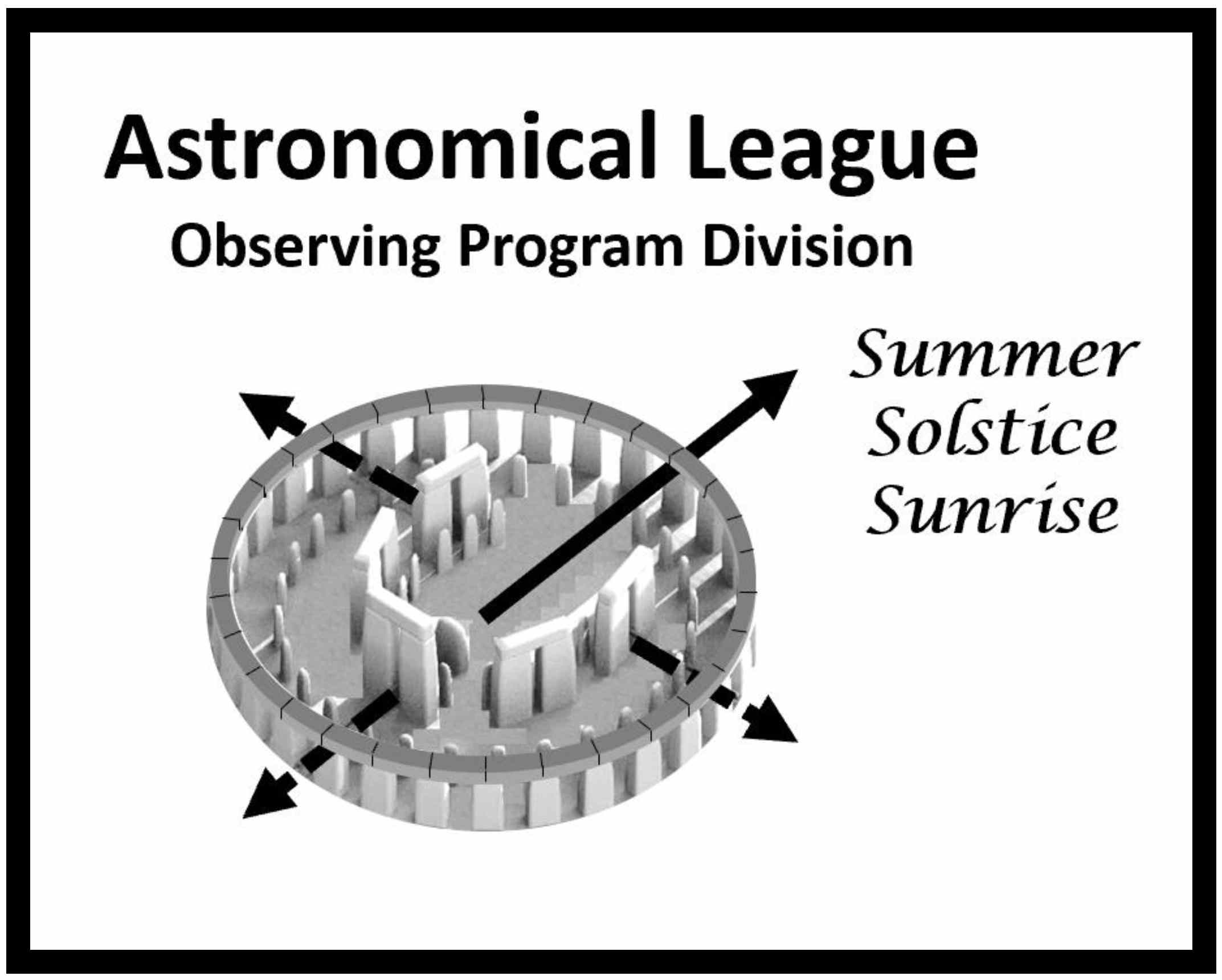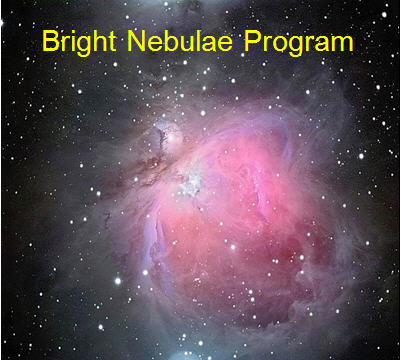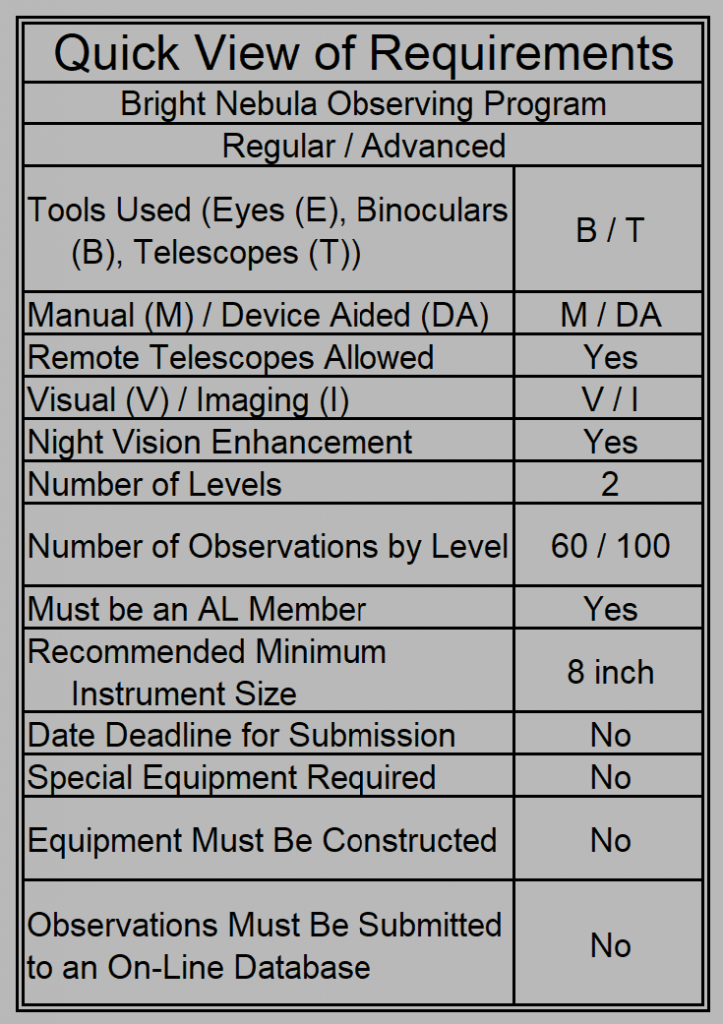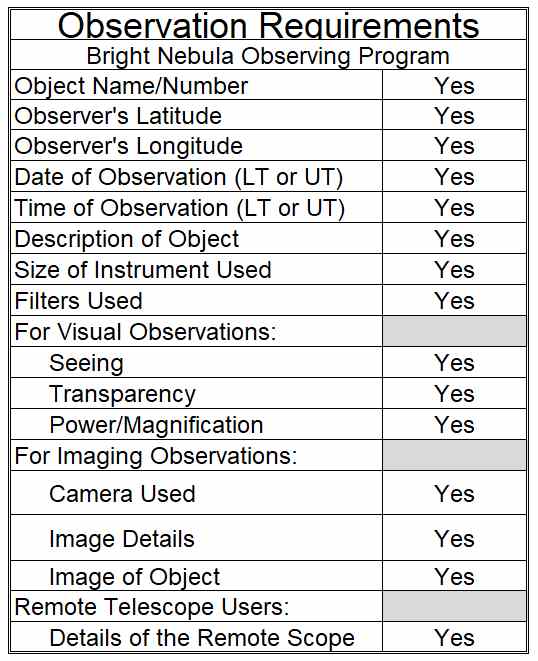Bright Nebula Observing Program Coordinator:Bob Scott |
  |
Introduction
| Welcome to the Astronomical League’s Bright Nebula Observing Program. Bright nebulae are interstellar clouds of gas and dust where stars are born or have died. Their complex shapes and rich colors make them objects of great interest and beauty to amateur astronomers. If you don’t already have an appreciation of these magnificent objects, it is hoped that this Observing Program will inspire you to study them and gain an understanding of stellar evolution.
Bright nebulae, also called diffuse or Galactic nebulae, occur in two main classes depending on their source of illumination: emission and reflection, although they occasionally are a combination of the two (R+E). Much less common is a third type of the bright nebula, the supernova remnant (SNR). Emission nebulae are clouds of dust and glowing hydrogen gas, sometimes referred to as H II regions. The atoms in the cloud are ionized by nearby hot stars and when the excited electrons fall back to their previous energy state, the process releases energy in the form of visible light. Since most of the light visible from emission objects comes from just the three bright lines produced by hydrogen (HB at 4861A) and oxygen (OIII at 5007A and 4959A, and the use of narrow-band nebula filters can be helpful in viewing them. Emission nebulae typically appear red in images, but not to the naked eye. |
 |
Reflection nebulae have the same composition as emission objects but lack stars sufficiently hot to cause the gas comprising them to fluoresce. Therefore, they shine merely by the dust in the nebula scattering starlight (the gas does not actually reflect any light). Because these objects scatter starlight of all colors, filters are not generally helpful in viewing them. Reflection nebulae appear blue in images.
A supernova remnant is the remains of a catastrophic stellar explosion, wherein much of a star’s material is ejected, often as a highly structured cloud. These objects have strong lines similar to emission nebulae, hence also benefit from the use of nebula filters.
Background Information
List of Objects:
Among the 150 bright nebulae chosen for this program are some of the most famous showpieces in the northern and southern skies. The list also contains examples across the entire range of bright nebulae. Some are bright and large enough to be visible with unaided eye or binoculars from a dark site. Others will appear in a telescope as ghostly apparitions that will severely test your powers of observation. You will need a telescope 8” or larger to complete this program.
Nebulae are easily washed out by light pollution, so finding a dark location from which you can observe will greatly assist in the amount of detail that you can see. Make sure to allow time for your eyes to become dark-adapted. Use averted vision and slight tapping of the telescope to detect the subtlest variations in brightness and contrast. Nebula filters (UHC and OIII) will help you expand the level of detail you can discern. Beware that even if you use these tips, there is much you will miss if you do not take your time with an observation.
There is the possibility that a few of the objects may simply be beyond detection for some observers and we will allow negative observations in completion of the Gold Level. Evidence of diligent efforts to observe an object is required (see Requirements and Rules).
The list has been developed to offer objects that will allow observers in both the northern and southern hemispheres to complete the Bright Nebula Observing Program.
Nebulae vary in brightness according to Lynd’s Catalog of Bright Nebula, which uses a scale of 1-6, where 1 is the brightest and 6 is barely detectable. Provided sufficient aperture is used under dark skies, experience suggests most category 1 and 2 emission nebulae and SNRs are within visual range. Category 3 objects will prove difficult, while those rated 4 and above are likely to be beyond the visual range and thus candidates for imaging instead. When compared with the same scale, reflection nebulae are generally considered to be more difficult to observe visually. In this program, you are to estimate the brightness of the nebulae using the Lynd’s Brightness Scale. This will give you an additional way to describe and compare the bright nebulae you observe.
The list of observing targets has been updated to include these brightness estimates from Lynd’s Catalog. In addition, the coordinates of each object have been updated to match those in the Field Guide of the Uranometria 2000 Deep Sky Atlas.
The Awards: The program offers three levels of accomplishment: a Silver Level and Gold Level and an imaging Gold Level. The Silver Level visual program requires you to observe at least 60 objects on the list. A certificate is awarded for the Silver Level. The Gold Level visual program requires you to attempt to observe at least 100 objects for which you will receive a certificate and pin, which sports a colorful image of the Great Orion Nebula. To complete the Gold Level by imaging, 100 objects must be successfully imaged. A Gold Level certificate and pin will be awarded for the imaging program. Observers are encouraged to try imaging as well as visual observing, but only one pin will be awarded.
Requirements and Rules
This certification is available to members of the Astronomical League, either through their local astronomical society or as members at large. If you are not a member and would like to become one, check with your local astronomical society, search for a local society on the Astronomical League Website, or join as a Member-at-Large .
Device-aided searches are allowed. Observers reporting that 100% of the objects observed were located manually by traditional star-hopping techniques will receive special recognition on their certificates. Use of publicly available remote-controlled telescopes via an internet connection is allowed, but you must control the acquisition of the images. Contact the Coordinator of the Bright Nebula Observing Program if you are unsure whether your plan meets these requirements.
“Negative observations” will be accepted for the Gold Level visual program only if sufficient evidence is submitted to establish that the proper field was examined on at least two separate attempts and every reasonable effort was made to detect the object. The maximum number of negative observations accepted is limited to 5.
To record a negative observation, the observer must make at least two observing attempts on different nights, record all of the data required for a standard observation and describe in detail the methodology used to confirm that the proper position was examined. Each negative attempt MUST include a sketch of the star field. Observers are encouraged to make as many attempts to detect the object as possible and to submit negative observations only as a last resort. Negative observations will not be accepted for the Silver Level.
The observer may use the log sheet provided with this guide or may use a log of his/her own design so long as all of the required information is recorded. The record of observations must include for each object:
|
 |
If you choose to make a sketch of the nebula, please note that artistic talent is not required. Just draw what you see as well as your ability allows. Use a number 2A lead pencil for best results. To make a drawing first mark the brightest field stars, then use these to guide you to the area you shade in to represent the shape and extent of the cloud of gas and dust. To indicate a brighter area simply shade that spot more darkly with the pencil. A dark lane through the nebula would be indicated by simply leaving the area blank white.
The record of observations for imaging is the same as for the visual certification, except that instead of a detailed description of the object, this information should be included:
- The specifics of the instrument used to make the image should be recorded.
- Exposure times, image software, number of stacked images and the like should also be provided.
Any camera that records an image through the optics of a telescope may be employed. In cases where there is more than one nebula present in an image. An overlay, companion sketch or other method must be used to clearly identify the target nebula.
Submitting for Certification
| Observers should submit their observing logs and drawings or images along with the completed submission form to their society’s awards coordinator. The awards coordinator shall examine the log and images and report completion of the program to the League’s Bright Nebulae Observing Program Coordinator either by mail or e-mail using the submission form. Please indicate if the certificate should signify that 100% of the objects were located manually.
Members at Large or members of societies that do not have awards coordinators should submit logs and images along with the submission form directly to the Bright Nebulae Observing Program Coordinator. It is recommended that only copies of your log and drawings/images be sent; we will not return originals unless the observer provides for postage. |
 |
Images in electronic format may be forwarded by any convenient means that accomplishes transfer or makes the images available for review. This may include the mailing of a storage device such as a CD or flash drive, or posting the images on the web. Please avoid sending prints or slides, as they will NOT be returned.
Your recognition (certificate, pin, etc.) will be mailed to the address provided, either to the observer or to a society officer for presentation.
It is hoped that this Observing Program will whet your appetite for observing additional bright nebulae. There are many hundreds more visible in amateur-size telescopes.
Clear Skies!
Vincent S. Foster (Original Developer)
Bright Nebulae Observing Program Coordinator:
Bob Scott
20663 English Rd.
Mount Vernon, WA 98274
re.bob.scott@gmail.com
Upon verification of your submission and of your active membership in the Astronomical League, your recognition (certificate, pin, etc.) will be sent to you or to the awards coordinator for your society, as you specified. Your name will also appear in an upcoming issue of the Reflector magazine and in the Astronomical League’s online database. Congratulations. Good luck with your next observing challenge.
Notes:
Recommended Reading:
- Coe, Steven R., Nebulae and How to Observe Them, Springer-Verlag, NY 2007
- Handy, R., et al, Astronomical Sketching, A Step-by-Step Introduction, Springer-Verlag, NY 2007
Links:
- List of Bright Nebulae: download as pdf, download as Excel Spreadsheet
- Observing Log: download as a Word Doc
- Observing Log: download as a PDF File
- Submission Form: download as a Word Doc
- Submission Form: download as a PDF File
- Find your Observing Program Award



